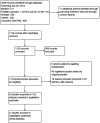Umbilical Cord Management for Newborns <34 Weeks' Gestation: A Meta-analysis
- PMID: 33632931
- PMCID: PMC7924139
- DOI: 10.1542/peds.2020-0576
Umbilical Cord Management for Newborns <34 Weeks' Gestation: A Meta-analysis
Abstract
Context: The International Liaison Committee on Resuscitation prioritized scientific review of umbilical cord management strategies at preterm birth.
Objective: To determine the effects of umbilical cord management strategies (including timing of cord clamping and cord milking) in preterm infants <34 weeks' gestation.
Data sources: Cochrane Central Register of Controlled Trials, Medline, PubMed, Embase, CINAHL, and trial registries were searched through July 2019 for randomized controlled trials assessing timing of cord clamping and/or cord milking.
Study selection: Two authors independently assessed trial eligibility, extracted data, appraised risk of bias, and assessed evidence certainty (GRADE).
Data extraction: We identified 42 randomized controlled trials (including 5772 infants) investigating 4 different comparisons of cord management interventions.
Results: Compared to early cord clamping, delayed cord clamping (DCC) and intact-cord milking (ICM) may slightly improve survival; however, both are compatible with no effect (DCC: risk ratio: 1.02, 95% confidence interval: 1.00 to 1.04, n = 2988 infants, moderate certainty evidence; ICM: risk ratio: 1.02, 95% confidence interval: 0.98 to 1.06, n = 945 infants, moderate certainty evidence). DCC and ICM both probably improve hematologic measures but may not affect major neonatal morbidities.
Limitations: For many of the included comparisons and outcomes, certainty of evidence was low. Our subgroup analyses were limited by few researchers reporting subgroup data.
Conclusions: DCC appears to be associated with some benefit for infants born <34 weeks. Cord milking needs further evidence to determine potential benefits or harms. The ideal cord management strategy for preterm infants is still unknown, but early clamping may be harmful.
Copyright © 2021 by the American Academy of Pediatrics.
Conflict of interest statement
POTENTIAL CONFLICT OF INTEREST: Ms Seidler is the chair of the individual participant data on Cord Management at Preterm Birth (iCOMP) Collaboration, a meta-analysis on cord clamping management using individual participant data. Dr Duley was chief investigator for the Cord Pilot Trial, collaborator for Australian Placental Transfusion Study, and a member of the secretariat for individual participant data on Cord Management at Preterm Birth. She was awarded a National Institute for Health Research grant for applied research for a program of work on care at very preterm birth, which included the Cord Pilot Trial. Ms Gyte was an investigator for the Cord Pilot Trial. Prof Rabe is the main author for 2 included studies in this review. In the event that an author of this review was also an author on an included study, that author did not assess eligibility, extract data, or assess risk of bias for the study on which he or she was an author. Dr Soll and Ms Ovelman work in the editorial office for Cochrane Neonatal, which received a contract from the American Heart Association as a Knowledge Synthesis Unit to undertake this systematic review for International Liaison Committee on Resuscitation. Dr Soll was a collaborator for the Australian Placental Transfusion Study; the other authors have indicated they have no potential conflicts of interest to disclose.
Figures





References
-
- Weiner GM, Zaichkin J; American Academy of Pediatrics; American Heart Association . Textbook of Neonatal Resuscitation (NRP), 7th ed. Elk Grove Village, IL: American Academy of Pediatrics; 2016
-
- Blencowe H, Cousens S, Oestergaard MZ, et al. . National, regional, and worldwide estimates of preterm birth rates in the year 2010 with time trends since 1990 for selected countries: a systematic analysis and implications. Lancet. 2012;379(9832):2162–2172 - PubMed
-
- World Health Organization; March of Dimes; The Partnership for Maternal, Newborn & Child Health; Save the Children . Born Too Soon: The Global Action Report on Preterm Birth. Geneva, Switzerland: World Health Organization; 2012
-
- Fogarty M, Osborn DA, Askie L, et al. . Delayed vs early umbilical cord clamping for preterm infants: a systematic review and meta-analysis. Am J Obstet Gynecol. 2018;218(1):1–18 - PubMed
-
- Rabe H, Sawyer A, Amess P, Ayers S; Brighton Perinatal Study Group . Neurodevelopmental outcomes at 2 and 3.5 years for very preterm babies enrolled in a randomized trial of milking the umbilical cord versus delayed cord clamping. Neonatology. 2016;109(2):113–119 - PubMed
Publication types
MeSH terms
LinkOut - more resources
Full Text Sources
Other Literature Sources
Medical

